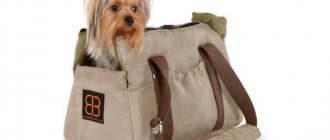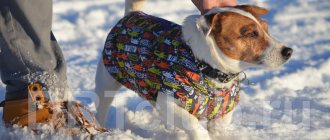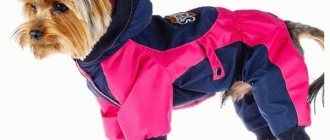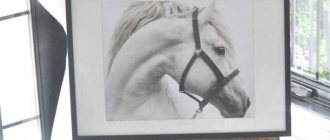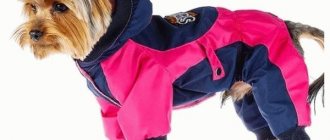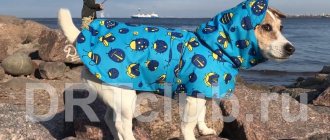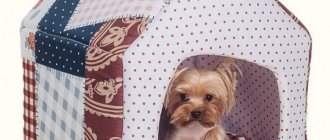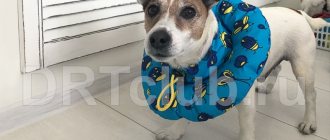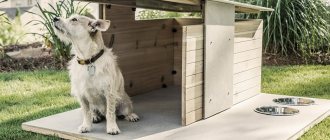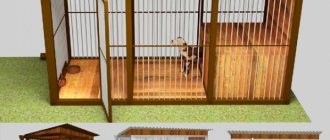Four-legged friends, like little children, have a very difficult time withstanding windy and cold weather. Short-haired dogs especially suffer from bad weather. Long-haired dogs have their own problems, because after every autumn-spring walk, their well-groomed fur gets dirty and wet. Hats, vests and overalls can protect your pet from cold and rain. It’s very easy to sew such things, and it doesn’t require much time or money. It is enough to change your own jacket or raincoat to match your dog’s wardrobe.
Sizes of overalls for dogs
The comfort and well-being of a dog during a walk directly depends on properly sewn clothes. It is important to choose the size very accurately so that your pet can wear it with pleasure. The size chart is selected according to several criteria: weight and measurements taken. To determine weight, you can use one of the following methods:
- weigh the dog on a culinary scale,
- weigh yourself with your pet in your arms, and then do it yourself and find the difference.
Of course, it would be more correct to take the parameters from the dog itself, but there are some nuances here too:
- measurements are taken only when the animal is standing,
- to determine the volume, use the widest places,
- with borderline data they tend to increase the size,
- When measuring the chest, take into account the value of the widest part of the chest (under the front legs) and add 2-3 cm to the result obtained.
- The neck size is equated to the length of the collar or the widest part of the neck is measured.
Knowing only the length of the back, you can immediately find out the size of the dog's overalls.
When starting to work on clothes for your pet, be sure to take into account its breed. As a rule, insulated outfits are not sewn for long-haired dogs.
For large pets
Before you start sewing, you need to decide on the fabric.
For large dogs, it is best to use bologna, as it washes well and dries quickly.
Below is a pattern that you can use to sew a costume for your pet. Moreover, you can sew all three types of overalls.
So, first, let's take measurements:
- Measure A - length from neck to tail;
- Measurement B - length from the neck to the hand of the front paw;
- Measure C - length from the neck to the hand of the hind paw;
- Measure D - neck circumference.
This concludes the taking of measurements. The pattern has angles a and b, they need to be made obtuse, this is about 135 degrees, maybe less, but not much. Thanks to them, your pet will be able to move around calmly.
After taking measurements, you need to create a pattern. Then cut it out and trace it onto the fabric. We cut out two identical parts from the material from which you will sew. We sew them together, just remember to leave the paws, neck and tail unsewn. We process all seams with bias tape, if necessary, insert elastic bands.
We also invite you to look at a selection of costume patterns for a girl’s dog and a boy’s (male) dog:
Pattern of overalls for a dog with a comfortable cut
The design of the overalls and its practicality directly depend on the chosen pattern and source material. It is advisable to use natural fabrics for an animal’s wardrobe. They are pleasant to the touch, allow the skin to breathe, are hypoallergenic, do not cause irritation, do not wrinkle or electrify. Cotton overalls do not fade or fade. Of course, overalls made of microfiber and neoprene are available on sale. They also have their advantages: they have increased wear resistance and thermal insulation, and serve as good protection from the wind. The lining for a dog's wardrobe is often silk or satin, and fleece and padding polyester are used for insulation. The slippery lining greatly simplifies the operation of the overalls and prevents wool from matting. When sewing, they also take into account the seasonality of the use of things; if you are sewing an autumn jumpsuit, it is better to opt for water-repellent fabric. Below is an example of a standard pocket pattern that can be used for most breeds. First, the template is printed on paper and, based on the measurements, transferred to fabric.
Making your own pattern will be more accurate. It is based on accurate measurements of the pet. First, determine the length of the pet’s back, for example 32 cm. Then the result obtained is divided by 8, i.e. 32:8= 4 (cm). Thus, the length of the sides of the square of the dimensional grid is obtained, which is used to transfer the pattern.Remember, dogs do not like clothing that is tight and restricts movement. The pants should not drag along the road; the cuffs should be secured with a lace or elastic band.
What's included in the wardrobe
The following elements may be present in the wardrobe of a four-legged friend:
- Overalls
- Coat
- Jacket and trousers
- Sweater, vest, sleeveless vest
- T-shirt
- Scarf
- Panama hat, scarf
- Shoes, socks
- Harness, collar
All this can be purchased at your nearest pet store, or done yourself.
Boy's dog jumpsuit
Boys' overalls have their own cut features. Models must have a deep cutout on the stomach, which will allow the animal to relieve itself without hindrance. In boys' clothing, dark colors predominate. Although some dog breeders dress their pets in bright outfits with reflective inserts. Such a dog is clearly visible while walking in the evening. Boys' overalls are modest and simple. Decorative elements can include appliques, braid, buttons and chains. The colors of clothing are most often represented by khaki, checkered and jacquard patterns. When choosing an outfit for a boy, they are guided by the principle of comfort and practicality. The model is selected exactly in size, taking into account the anatomical features of the pet. It should not hinder movement and sag when walking. When choosing a jumpsuit, especially for long-haired dogs, pay attention to the fasteners. Hair sticks to the Velcro and can get tangled in the zipper. In this case, it is best to take clothes with ties or buttons.
Examples of boyish models
Does a Spitz need clothes?
It may seem that fluffy Pomeranians do not need additional insulation with clothing. In fact, pets need costumes not only in winter, but almost all year round.
Clothing will protect them from external dangers: ectoparasites, microbes, sunlight, clinging plants, debris.
Spitz shoes are necessary to preserve the skin on the pads of the paws. It often cracks from salts and reagents that are sprinkled on roads in winter. And in the summer, hot asphalt can burn a dog's paws.
In addition, a Spitz can easily be injured by small pieces of glass, thorns and iron cans.
Jumpsuit for girls dog
Girl dogs, like real fashionistas, can have a whole wardrobe of bright and spectacular outfits. Dressed dogs of small breeds evoke tenderness and real delight. Girls' overalls have a closed midriff. Models of shaggy fashionistas are decorated with floral prints, rhinestones, beads, ruffles and bows. For girls, overalls are chosen in red or pink, although beige tones have always been considered the most popular. Usually dogs get so used to their outfit that, in the absence of clothes, they show their character. Of course, you can buy clothes for girls, but it would be better to order them tailored to your individual measurements. When choosing dog clothes, you should remember not only beauty, but also practicality and convenience. The fabric for sewing should not be too hard, rustling or wrinkled. It is important to carefully make all the seams so that when worn they do not rub or injure the delicate skin of the animal.
Examples of girls' overalls
Choosing fasteners
The well-chosen method of fastening determines whether putting on the costume will be comfortable for your pet or not. The following can be used as fasteners:
- rivets - they are convenient to fasten on costumes for small dogs;
- Velcro (easy to fasten, but additional fastenings are required);
- laces (used on outfits of small breeds and do not need to be sewn);
- elastic bands (very versatile and can be used for dogs of different sizes and weights).
Sew a jumpsuit for a dog
Of course, it’s easier to buy overalls for your pet in the store, but there is no guarantee that it will sit well on it. Often, a model is cut out according to a standard template, so the anatomical features of a particular breed are not always taken into account. Homemade overalls are sewn for a specific dog, based on its measurements.
To sew a dog outfit you will need:
- Waterproof fabric, the edges of which should not fray. This can be raincoat fabric or bolognese material. It is much easier to work with such a base.
- The overalls can be insulated with fur, synthetic padding and viscose.
- It is better to use a tractor zipper. It is more reliable and durable, so the dog cannot break it with its teeth.
- For adjustment, choose an elastic band with a round cross-section.
- The collar is secured with Velcro, snaps or buttons.
It is advisable to make the first trial version of the overalls from an old sheet and only then work with the main material.
Video instruction
I bring to your attention a detailed master class on how to easily and simply sew a new thing for a ponytail for autumn rainy weather.
Jacksik and I hope that you liked this blanket and you will definitely make a new outfit for your favorite wet nose. Share the video with your dog lover friends. Write your reviews in the comments and ask questions if you have any.
Good luck and take care of your pets!
Overalls for dogs step by step instructions
The construction of the pattern begins by taking basic measurements. Having decided on the dimensions, you can prepare the necessary material and tools. Then a pattern is selected. It can be the simplest when only one measurement is taken into account - the length of the back. Based on this parameter, the remaining dimensions are increased.
The next pattern is based on the previous one, but has separate sleeves and legs. Such models are chosen for non-standard dog shapes.
The third pattern is suitable for experienced craftswomen. It has a hood and cuffs.
The pattern is increased based on the length of the back divided by 8, and transferred to tracing paper. Copies of the details are placed on whatman paper or a piece of old wallpaper. The template is cut out and transferred to fabric. It is advisable to secure the parts with pins. The contours are outlined with chalk and cut out with a seam allowance (1–1.5 cm). For decoration, you can use contrasting inserts.
The contours of the pattern are also transferred to the insulation and the necessary parts are cut out. Having folded the outer and lining fabric together, the blanks are sewn together. You can baste them first and then stitch them.
The order of sewing is as follows: first, the parts in the chest area are connected, then the front legs, side inserts and back parts.
A cord is placed in the side insert.
The jumpsuit is decorated with a collar made of contrasting fabric. The folded parts are right side inward, stitched and turned inside out. The blank is sewn to the overalls.
An elastic band is inserted into the collar and the edges are secured with Velcro. A new outfit for your pet is ready.
Necessary materials
To make the jumpsuit I used the following materials:
- Membrane fabric with water protection.
- Lining fabric on padding polyester (lining stitch). Depending on how warm or not you want the overalls to be, you can use a thinner fabric (for example, flannel, fleece) as the lining layer. If you plan to use the overalls in severe frosts, then as an additional insulating layer you can use Alpolux insulation, which is quite frost-resistant.
- Tractor lightning. If you sew a zipper only along the back (without a collar), as I did, then the length of the zipper must be exactly the same as the length of your pet’s back (in my case it is 30 cm). If you plan to “extend” the zipper to the end of the collar, then its length should accordingly be greater.
Jack always wears collars with us. If I had sewn a zipper along the entire length of the overalls, including the collar, then I would have to put Jack's collar on top of the collar. After all, if I wore the collar down, the leash would constantly rub against the collar, but I don’t think that’s very comfortable. In my opinion, the long lock option is suitable if your pet wears a harness.
Knit overalls for a dog with knitting needles, diagram with explanations
A dog's overalls can be knitted from wool, and the insulation can be fur or viscose. The order of knitting is as follows: first they work on the collar, then they shape the chest with holes for the front legs. The length of the finished product should be compared with the size of the dog. Knitted patterns are suitable for most dog breeds.
Work on overalls begins by determining the knitting density. If 24 loops are placed in 10 cm, then the density is 2.4. For a 22 cm chest circumference, you will need to cast on: 22 x 2.4 = 52.8 loops.
The given pattern is designed for a model with a back length of 22 cm and a chest circumference of 34 cm. Work begins by casting on 52 loops (P). Knit 27 rows in stockinette stitch. Then they begin to knit the elastic. To do this, perform 6 rows with a simple 1x1 elastic band. Switch to stockinette stitch again and knit 3 rows. For the opening of the sleeves, close 6 P. The distance between the sleeves should be 12 P. Then knit 21 P for the front and 12 P for the back. Having knitted 6 cm with an elastic band, knitting is continued and closed in the lower zone with 24 P. In the center, 12 P are closed, the corners are tied separately. In the middle of each row, 2 P are gradually closed. For the paws, 30 P are cast on and 20 R are knitted in a circle. The parts are connected to the base with a hook or a needle. The hood is sewn together.
We take basic measurements from the pet
To begin with, let's take basic measurements from the dog (as shown in the photo below): back length, neck girth and chest girth. If you are sewing a blanket or vest, these measurements are quite sufficient.
But if you want to make overalls for a dog, then it would be a good idea to also measure the length of his paws so that after cutting the legs do not end up being too short. Although, this too can be easily corrected by “increasing” the decorative cuffs.
Crochet overalls for dogs, diagram with explanation
The overalls are made in several stages from the main fabric, sleeves and neck. They work from the bottom up. Cast on 20 air loops (VP).
The 1st row starts with 3 VP, 20 double crochets (SC).
The work is turned over and 3 VP lifts are made. In the 2nd row, increase in the last loop to make 22 ST.
11 rows go the same way. In the 10th stitch, 30 double crochets are knitted, in the 11th stitch - 32 double crochets. At the end of the 11th row, add 20 VP.
In the 12th row, 53 ST are knitted. The 13th and 14th rows are performed similarly.
In the 15th row, they begin to form the slots for the paws: the first 4 loops are tied in half-columns.
The knitting is raised with 3 ch, and then 25 dc are knitted. Cast on 8 VPs and connect them with STN, skipping 8 Ps from the previous row. Knitting continues with STN. After 14 ST, make 8 VP and finish the row.
After knitting two rows in a circle, the main part is completed.
The neckline can be knitted with 1x1 elastic knitting needles. 1st row: 1 P is removed, LP, IP, LP, and so on until the end of the row. The 2nd row is performed according to the drawing.
The neckline is made with knitting needles (No. 4) from 68 stitches. After knitting 14 rows with an elastic band, the loops are closed.
For sleeves, cast on 30 P and go through 7 rows with an elastic band.
The finished parts are crocheted together.
How to make a big dog jumpsuit
Overalls for large dogs are very rare on sale. Homemade models are made on the basis of one-piece templates.
The size chart for large breeds starts from 2XL and ends with L.
Overalls are made of waterproof materials. The basis can be an old out-of-fashion raincoat or a small jacket. A prerequisite for sewing dog clothes yourself is a loose fit and practicality. The overalls are sewn according to a pattern, which is enlarged according to the dog's back dimensions (A).
Detailed instructions for sewing autumn-spring overalls for a large breed dog:
What is included in a standard pug wardrobe?
Clothing for pugs is divided by season. The basic wardrobe includes:
- overalls;
- hats;
- coat;
- sweaters;
- scarf;
- shoes and socks;
- sweatshirts;
- jacket and trousers;
- T-shirts.
A jumpsuit for your pug is the most comfortable and practical outfit. It can be sewn or knitted. It would be good if it also had a hood that would protect your dog’s ears. You can wrap a knitted scarf around your neck. In bad winter weather, you can’t do without boots, which would also be nice to wear socks under. Shoes for a small pug are not the whims of the owners, but protect their paws from cold snow, wet grass and puddles.
It's raining outside - then put a raincoat with a hood on your pet, because the sound of falling rain is harmful to the dog's ears. You should definitely have several special pug hats in your wardrobe. For summer, these can be panama hats or scarves, for winter - knitted or fur hats. Sweaters and blouses for pugs are purchased for the autumn-spring period. In summer, wear cotton overalls or a T-shirt with shorts.
You need to accustom your pug to trying on and wearing clothes from an early age.
It will be more difficult to negotiate with an older dog. The dog may refuse to go anywhere in uniform, offended that they put something on him. If in the summer you can try to walk around without clothes, then in the winter the dog will feel bad without insulation. So take care of this in advance.

